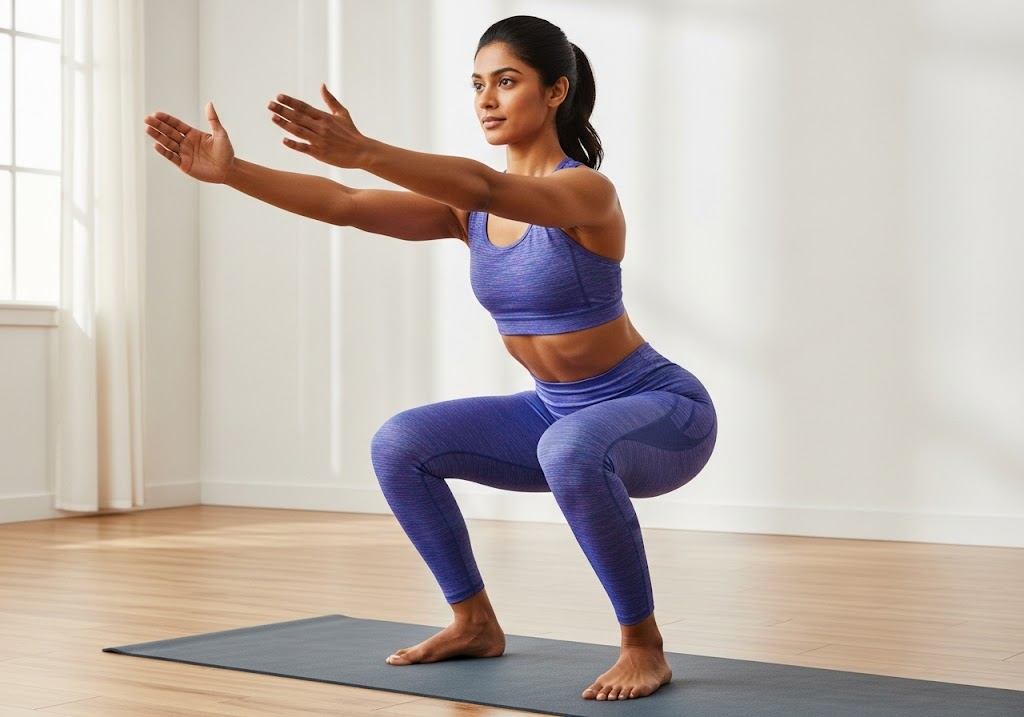Is it better to do cardio before or after weights? For muscle building and strength goals, it’s better to do cardio after weights, while endurance goals benefit from cardio first – the optimal choice depends entirely on your primary training objective. Key factors determining if it’s better to do cardio before or after weights are: Primary fitness goals, energy levels, performance priorities, recovery capacity, workout duration, training intensity, muscle building vs fat loss focus, and individual response to exercise sequencing.
Want to know if it’s better to do cardio before or after weights for maximum results? This common fitness dilemma affects millions of people trying to optimize their workout routines. The answer depends on your specific goals, whether you prioritize strength building, fat loss, or overall fitness improvement.
Table of Contents
Is It Better To Do Cardio Before or After Lifting Weights?
The question of whether it’s better to do cardio before or after weights has no universal answer, as the optimal sequence depends entirely on your primary fitness goals and training priorities. Research shows that exercise order significantly impacts performance and results in both cardiovascular and strength training adaptations.
For strength and muscle building goals, it’s generally better to do cardio after weights to preserve energy for heavy lifting. Conversely, if cardiovascular fitness or endurance performance is your priority, doing cardio before weights may be more beneficial for achieving those specific adaptations.
| Primary Goal | Better Sequence | Reason | Performance Impact |
|---|---|---|---|
| Muscle Building | Weights First | Preserves energy for heavy lifting | 15-20% strength maintenance |
| Fat Loss | Either Order | Total calories matter most | Minimal difference |
| Endurance Performance | Cardio First | Prioritizes cardiovascular adaptation | 10-15% cardio improvement |
| General Fitness | Personal Preference | Both provide benefits | Moderate impact either way |
| Time Efficiency | Combined Training | Maximizes limited workout time | Some compromise both ways |
Understanding the science behind exercise sequencing helps determine what’s better for your specific situation when asking is it better to do cardio before or after weights. Consider your energy levels, recovery capacity, and long-term training goals when deciding if it’s better to do cardio before or after weights in your routine.
For developing the foundational strength that supports both cardio and weight training, how to do a perfect squat provides essential movement patterns for optimal performance.

How to Structure Your Workout?
Structuring your workout effectively requires understanding how different exercise orders impact performance and results. The decision of whether it’s better to do cardio before or after weights should align with your workout structure and available time for optimal training outcomes.
Option 1: Weights First Approach
Begin with a dynamic warm-up, followed by strength training, then conclude with cardiovascular exercise. This structure preserves energy for heavy lifting while using cardio as an active recovery method to promote blood flow and nutrient delivery.
Option 2: Cardio First Approach
Start with cardiovascular exercise, then transition to strength training after adequate rest. This approach works well when cardiovascular fitness takes priority or when using light cardio as an extended warm-up before lifting sessions.
Option 3: Split Training
Separate cardio and weights into different sessions or days entirely. This method eliminates interference effects and allows maximum performance in both training modalities, though it requires more total training time throughout the week.
| Workout Structure | Time Required | Energy Demands | Best For | Recovery Needs |
|---|---|---|---|---|
| Weights → Cardio | 60-90 minutes | High → Moderate | Strength goals | 24-48 hours |
| Cardio → Weights | 60-90 minutes | Moderate → High | Endurance goals | 24-48 hours |
| Separate Sessions | 45-60 each | Focused intensity | Optimal performance | 48-72 hours |
| Circuit Training | 45-60 minutes | Consistently high | Time efficiency | 24-48 hours |
Choose the structure that best matches your schedule, energy patterns, and primary training objectives. Consistency with your chosen approach matters more than perfect optimization for most fitness enthusiasts.

When to Do Cardio Before Strength Training?
Choosing when it’s better to do cardio before or after weights depends on specific situations where cardiovascular adaptation takes priority or when using cardio as an extended warm-up. Understanding these scenarios helps optimize your training sequence for particular goals and circumstances.
| Situation | Cardio Type | Duration | Intensity | Strength Impact | Best For |
|---|---|---|---|---|---|
| Endurance Priority | Running/Cycling | 30-60 min | Moderate-High | Moderate reduction | Endurance athletes |
| Warm-up Purpose | Light movement | 5-10 min | Low | Minimal | General preparation |
| Fat Loss Focus | Steady-state | 15-25 min | Moderate | Low-moderate | Weight loss goals |
| Time Constraints | HIIT | 10-15 min | High | Moderate-high | Busy schedules |
| Recovery Day | Easy pace | 20-30 min | Low | Minimal | Active recovery |
For comprehensive bodyweight training that combines both elements, calisthenics exercises provides excellent options for integrated cardiovascular and strength development.

When to Do Strength Training Before Cardio?
Strength training before cardio is generally the better approach when deciding if it’s better to do cardio before or after weights for muscle building, strength gains, or power development goals. This sequence preserves energy and focus for heavy lifting while using cardio as a recovery tool.
| Goal | Strength Focus | Cardio Type | Benefits | Typical Schedule |
|---|---|---|---|---|
| Muscle Building | Heavy compounds | Light-moderate | Preserves lifting energy | 3-4 strength, 2-3 cardio |
| Strength Gains | Progressive overload | Recovery pace | Maximum force production | 4-5 strength, 2 cardio |
| Power Development | Explosive movements | Low intensity | Neural system preservation | 3-4 power, 2-3 easy cardio |
| Body Composition | Moderate-heavy | Moderate intensity | Muscle preservation + fat loss | 3-4 strength, 3-4 cardio |
| Athletic Performance | Sport-specific | Variable | Performance enhancement | Sport-dependent |
For building the back strength that supports heavy lifting, how to get a wider back provides essential exercises for developing pulling strength and posture.

Can You Combine Cardio and Strength Training?
Yes, you can effectively combine cardio and strength training in single sessions when deciding if it’s better to do cardio before or after weights, though this approach requires careful planning to maximize benefits while minimizing interference effects. Circuit training and concurrent training represent effective methods for integration.
The key to successful combination training lies in managing intensity and volume appropriately while considering recovery demands. High-intensity work in both areas simultaneously can lead to overreaching, while moderate intensities allow sustainable progress in both strength and cardiovascular domains.
| Method | Structure | Benefits | Drawbacks |
|---|---|---|---|
| Circuit Training | Alternating exercises | Time efficient | Reduced max strength |
| Concurrent Blocks | Separate segments | Focused effort | Longer sessions |
| Supersets | Paired movements | Muscle efficiency | Complex programming |

How Much Cardio and Strength Training Do You Need?
The optimal amounts of cardio and strength training when determining if it’s better to do cardio before or after weights depend on your goals, experience level, and recovery capacity. Understanding minimum effective doses helps guide your exercise sequencing and volume decisions.
| Goal | Strength Training | Cardio | Weekly Total | Session Order | Recovery Needs |
|---|---|---|---|---|---|
| General Health | 2-3 sessions | 150 min moderate | 3-5 hours | Either order | 24-48 hours |
| Muscle Building | 3-4 sessions | 60-90 min total | 4-6 hours | Weights first | 48-72 hours |
| Fat Loss | 3-4 sessions | 180-240 min | 5-7 hours | Personal preference | 24-48 hours |
| Endurance Performance | 2-3 sessions | 300+ min | 6-8 hours | Cardio first | Variable |
| Athletic Performance | 4-6 sessions | Sport-specific | 8-12 hours | Goal-dependent | 48-72 hours |
For developing unilateral strength that supports both training types, unilateral exercises provides excellent single-limb movements for balanced development.
What Are the Benefits of Doing Cardio Before Weight Lifting?
Doing cardio before weight lifting offers specific benefits that make this sequence advantageous in certain situations and for particular goals. Understanding these benefits helps determine when this approach might be better than the alternative sequence.
- Enhanced Warm-up Effects: Light to moderate cardio before weights provides comprehensive warm-up benefits by increasing core body temperature, heart rate, and blood flow to working muscles. This preparation can improve lifting performance and reduce injury risk when done appropriately.
- Cardiovascular Priority: When cardiovascular fitness is your primary goal, doing cardio first ensures you can maintain optimal intensity and form for your most important training objective. This sequencing prioritizes your main goal while still including strength training benefits.
- Fat Oxidation Benefits: Some research suggests that doing cardio in a glycogen-depleted state (after an overnight fast) may enhance fat oxidation. Following this with strength training can provide muscle-building stimulus while potentially maximizing fat burning.
- Mental Preparation: The rhythmic nature of cardio can serve as mental preparation for strength training, helping some people transition into the focused mindset required for heavy lifting. This psychological benefit shouldn’t be underestimated for training consistency.
- Flexibility in Intensity: Starting with cardio allows you to adjust intensity based on daily energy levels. If you feel sluggish, lighter cardio can serve as activation, while high energy days can accommodate more intense cardiovascular work.
However, these benefits must be weighed against potential drawbacks, including reduced strength performance and compromised muscle-building stimulus when cardio intensity or duration is excessive.

What Are the Benefits of Doing Cardio After Weight Lifting?
Performing cardio after weight lifting provides several advantages that make this sequence preferable for most strength and muscle-building goals. These benefits explain why many fitness professionals recommend this approach for optimal results.
- Preserved Strength Performance: Doing weights first maintains your ability to lift maximum loads with proper form, which is essential for progressive overload and muscle building. This preservation of strength performance leads to better long-term results in muscle and strength development.
- Enhanced Recovery: Moderate cardio after weights serves as active recovery, promoting blood flow and nutrient delivery to muscles while helping remove metabolic waste products. This enhanced recovery can improve adaptation and reduce soreness between sessions.
- Improved Body Composition: The combination of preserved strength training intensity plus additional caloric expenditure from cardio creates optimal conditions for improving body composition through muscle gain and fat loss simultaneously.
- Time Efficiency: Using cardio as a cool-down extends your workout gradually rather than requiring a separate warm-up period, making the overall session more time-efficient while providing transition benefits.
- Metabolic Advantages: Strength training creates an elevated metabolic state that can enhance fat oxidation during subsequent cardio exercise. This metabolic priming effect may improve the efficiency of post-workout cardio for body composition goals.
- EPOC Enhancement: Post-exercise oxygen consumption remains elevated longer when cardio follows strength training
- Growth Hormone Response: The combined stimulus may enhance growth hormone release for recovery and adaptation
- Glycogen Utilization: Depleted glycogen from weight training can enhance fat oxidation during cardio
- Psychological Benefits: Ending with cardio can provide a sense of completion and additional accomplishment
For specialized back training that complements your workout routine, calisthenics back exercises provides excellent bodyweight options for developing pulling strength.
What Are the Benefits of Separating Cardio and Weight Lifting?
Separating cardio and weight lifting into different sessions eliminates interference effects and allows maximum performance in both training modalities. This approach provides the greatest potential for optimizing both cardiovascular and strength adaptations when time and schedule permit.
- Maximized Performance: Each training session can be performed at maximum intensity without compromise from the other training type. This optimization leads to superior results in both strength and cardiovascular adaptations compared to combined sessions.
- Enhanced Recovery: Separating training types allows more focused recovery between sessions. Strength training days can emphasize protein synthesis and muscle repair, while cardio days can focus on cardiovascular adaptation and active recovery.
- Reduced Interference: The molecular pathways for strength and endurance adaptations can sometimes conflict when stimulated simultaneously. Separation minimizes these interference effects, allowing each adaptation to proceed optimally.
- Specialized Focus: Each session can target specific adaptations without compromise. Strength days can emphasize heavy loading and technical skill, while cardio days can focus on different energy systems and intensities.
- Mental Freshness: Approaching each training type with a fresh mindset allows better focus and intensity. This mental aspect often translates to improved performance and adherence to training programs.
- Flexibility in Programming: Separate sessions allow you to manipulate training variables independently. Strength sessions can focus on progressive overload while cardio sessions can vary intensity and duration based on specific goals and recovery status.
| Separation Approach | Advantages | Disadvantages | Best For |
|---|---|---|---|
| Alternate Days | Clear recovery | More training days | Serious athletes |
| Morning/Evening Split | Same day benefits | Requires two sessions | Time-flexible people |
| Different Days | Maximum focus | Schedule complexity | Optimal performance goals |
| Weekly Blocks | Periodization benefits | Less frequent exposure | Advanced programming |
How Often Should You Do Weight Lifting and Cardio?
The optimal frequency for weight lifting and cardio depends on your goals, experience level, and recovery capacity. Understanding minimum effective frequencies helps you decide whether it’s better to do cardio before or after weights based on your weekly schedule and priorities.
- Strength Training Frequency: For muscle building and strength goals, 3-4 sessions per week provide optimal stimulus-to-recovery ratios. Each major muscle group should be trained 2-3 times weekly for maximum adaptation, though advanced trainees may benefit from higher frequencies.
- Cardiovascular Training Frequency: General health benefits can be achieved with 3-4 cardio sessions weekly, while specific performance goals may require 5-6 sessions. The intensity and duration of each session should be inversely related to maintain sustainable progression.
- Combined Training Frequency: When combining both training types, 4-6 total sessions weekly often provide the best balance of stimulus and recovery. This might include 3 strength sessions and 2-3 cardio sessions, or various combinations based on priorities.
- Recovery Considerations: More frequent training requires careful attention to recovery indicators including sleep quality, energy levels, motivation, and performance trends. Adjust frequency based on your individual response rather than following rigid prescriptions.
- Periodization Benefits: Varying training frequency throughout different phases can optimize adaptations and prevent staleness when considering is it better to do cardio before or after weights. Consider higher frequencies during base-building phases and lower frequencies during intense or peaking phases.
| Experience Level | Strength Sessions | Cardio Sessions | Total Weekly | Rest Days |
|---|---|---|---|---|
| Beginner | 2-3 | 2-3 | 4-5 | 2-3 |
| Intermediate | 3-4 | 3-4 | 5-6 | 1-2 |
| Advanced | 4-6 | 3-5 | 6-8 | 1-2 |
| Elite | 6-8 | 4-6 | 8-12 | 1-2 |
For women seeking similar training benefits, resistance band workouts for women provides gender-specific programming considerations, while resistance band workout for triceps offers targeted muscle development options.

How Do You Combine Strength Training and Cardio in One Workout?
Combining strength training and cardio in single workouts requires strategic planning to maximize benefits while minimizing interference effects. Several methods can effectively integrate both training types depending on your goals and time constraints.
- Circuit Training Method: Alternate between strength exercises and cardio intervals with minimal rest. This approach maximizes time efficiency while providing both cardiovascular and strength training stimulus, though it may compromise maximum strength development.
- Block Periodization: Perform strength training as one complete block, then follow with cardio as a separate block within the same session. This method allows focused effort on each training type while still combining them for convenience.
- Progressive Integration: Start with lower intensities and shorter durations for both training types, gradually increasing as your conditioning improves. This progressive approach allows adaptation while preventing overreaching.
- Recovery Management: Combined sessions increase total training stress, requiring careful attention to recovery indicators when deciding is it better to do cardio before or after weights. Monitor sleep, energy levels, and performance to ensure adequate adaptation between sessions.
- Superset Integration: Pair strength exercises with brief cardio intervals between sets instead of passive rest. This approach maintains cardiovascular elevation while allowing strength training to remain the primary focus of the session.
| Integration Method | Structure | Duration | Intensity | Best For |
|---|---|---|---|---|
| Circuit Training | 1:1 ratio | 45-60 min | Moderate | General fitness |
| Block Method | 30 min each | 60-75 min | High | Specific goals |
| Cardio Acceleration | 30-60 sec intervals | 45-55 min | Variable | Time efficiency |
| Complex Training | Paired exercises | 50-70 min | High | Athletic performance |
Core strength plays a crucial role in both cardio and weight training performance, and resistance band core exercises provides excellent options for developing the stability needed for optimal performance in both training modalities.
How to Build a Cardio and Strength-Training Routine?
Building an effective routine that includes both cardio and strength training requires systematic planning based on your goals, schedule, and recovery capacity. The question of whether it’s better to do cardio before or after weights becomes part of a larger programming strategy.
- Goal-Based Planning: Start by identifying your primary objective, whether it’s muscle building, fat loss, cardiovascular health, or athletic performance. This primary goal should influence the majority of your training decisions, including exercise order and time allocation.
- Schedule Integration: Consider your weekly schedule and energy patterns when deciding how to integrate both training types. Morning people might prefer cardio first thing, while evening trainees might benefit from strength training after work when energy is higher.
- Flexibility and Adaptation: Build flexibility into your routine to accommodate life stresses, changing priorities, and varying energy levels. A rigid routine that doesn’t adapt to circumstances often leads to missed sessions and decreased adherence.
- Monitoring and Adjustment: Track key indicators including energy levels, sleep quality, motivation, and performance metrics to guide routine modifications. Successful long-term programming requires ongoing assessment and adjustment based on your response.
- Progressive Development: Begin with conservative volumes and intensities, gradually increasing as your fitness improves. This progressive approach prevents overreaching while allowing sustainable long-term development in both areas.
| Phase | Duration | Focus | Strength:Cardio Ratio | Key Adaptations |
|---|---|---|---|---|
| Foundation | 4-6 weeks | Movement quality | 60:40 | Technique, base fitness |
| Development | 6-8 weeks | Progressive loading | 70:30 or 30:70 | Specific adaptations |
| Intensification | 3-4 weeks | Peak performance | Goal-dependent | Performance peak |
| Recovery | 1-2 weeks | Active recovery | 40:60 | Regeneration |
Can You Do Cardio and Weightlifting on the Same Day?
Yes, you can absolutely do cardio and weightlifting on the same day, though this approach requires careful planning to optimize benefits while managing fatigue and recovery. The question of whether it’s better to do cardio before or after weights becomes particularly relevant for same-day training.
- Performance Considerations: Same-day training typically results in some performance compromise in whichever exercise is performed second. The magnitude of this effect depends on the intensity, duration, and type of both training sessions.
- Recovery Implications: Combined training sessions increase total training stress and require more attention to recovery factors including nutrition, hydration, and sleep. Plan for longer recovery periods between intense combined sessions.
- Energy Management: Consider your daily energy patterns when scheduling combined sessions. Most people have higher energy earlier in the day, making morning sessions ideal for your priority training type.
- Practical Strategies: Use lower intensities for your secondary training focus, ensure adequate nutrition between sessions if training twice daily, and monitor recovery indicators to prevent overreaching from excessive combined training stress.
- Individual Response: Some people adapt well to same-day training while others perform better with separated sessions when considering is it better to do cardio before or after weights. Experiment with different approaches to find what works best for your goals, schedule, and recovery capacity.
- Long-term Sustainability: Consider whether your same-day approach is sustainable long-term when asking is it better to do cardio before or after weights. While effective for certain periods, you may need to adjust your strategy based on changing life circumstances and training goals.
For advanced calisthenics training that naturally integrates strength and cardiovascular elements, calisthenics planche provides challenging progressions for experienced practitioners.

Factors That Influence Your Decision
Several key factors should influence your decision about whether it’s better to do cardio before or after weights. Understanding these variables helps you make informed choices that align with your specific situation and goals.
- Primary Training Goals: Your main objective should be the primary determinant of exercise order. Muscle building and strength goals typically benefit from weights first, while endurance performance may require cardio priority.
- Time Constraints: Available training time influences how you can structure sessions. Limited time may require combined training, while flexible schedules allow for separated sessions that optimize each training type.
- Energy Patterns: Individual circadian rhythms and energy levels throughout the day should guide training timing. Schedule your priority training when energy is highest for optimal performance and results.
- Recovery Capacity: Your ability to recover from training stress influences how much and how frequently you can combine different training types. Age, sleep quality, stress levels, and nutrition all impact recovery.
- Individual Preferences: Personal enjoyment and adherence factors should influence your decision. The best program is one you’ll consistently follow, even if it’s not theoretically optimal.
- Life Circumstances: Work schedules, family commitments, and other life factors affect training consistency when deciding is it better to do cardio before or after weights. Choose an approach that fits your current circumstances rather than an ideal that’s unsustainable.
For nutritional strategies that support your training approach, intermittent fasting plan provides timing strategies that can complement your exercise schedule.
Common Mistakes to Avoid
When deciding whether it’s better to do cardio before or after weights, several common mistakes can undermine your results and progress. Avoiding these errors helps optimize your training approach and prevents frustration with poor outcomes.
- Excessive Cardio Before Weights: The most common mistake is performing too much or too intense cardio before strength training, which significantly compromises lifting performance and muscle-building potential. Keep pre-strength cardio light and brief if included.
- Ignoring Individual Response: Following rigid rules without considering your individual response leads to suboptimal results. Monitor your performance and energy levels to determine what sequence works best for your specific situation and goals.
- Inadequate Recovery Planning: Failing to account for increased recovery demands when combining training types can lead to overreaching and poor adaptations. Plan for adequate rest between intense combined sessions.
- Goal Misalignment: Using exercise order that doesn’t match your primary goals wastes training time and limits results. Ensure your approach prioritizes your most important training objective.
- Flexibility Avoidance: Being too rigid with your approach prevents adaptation to changing circumstances, energy levels, and training responses. Build flexibility into your routine for long-term success.
- Progress Monitoring Neglect: Failing to track relevant metrics makes it impossible to determine whether your chosen approach is working effectively for your goals.
Making Your Personal Decision
Ultimately, determining whether it’s better to do cardio before or after weights requires honest assessment of your goals, circumstances, and individual response patterns when asking is it better to do cardio before or after weights. No single approach works optimally for everyone in all situations.
- Start with Your Goals: Let your primary training objective guide your initial decision when determining is it better to do cardio before or after weights. Muscle building typically benefits from weights first, while endurance goals may favor cardio priority. General fitness allows more flexibility in sequencing.
- Experiment Systematically: Try different approaches for 4-6 week periods while monitoring key performance indicators to answer is it better to do cardio before or after weights for you. This systematic experimentation helps you discover what works best for your unique situation.
- Consider Your Lifestyle: Choose an approach that fits your schedule, energy patterns, and life circumstances when deciding is it better to do cardio before or after weights. Sustainability matters more than theoretical optimization for most people’s long-term success.
- Stay Flexible: Be willing to adjust your approach based on changing goals, circumstances, or responses to the question is it better to do cardio before or after weights. What works during one phase of life may need modification as situations change.
Your decision about whether it’s better to do cardio before or after weights should be based on evidence from your own experience rather than generic recommendations. Trust your body’s responses while staying open to modifications as your fitness journey evolves.
Conclusion
The question of whether it’s better to do cardio before or after weights depends entirely on your individual goals, circumstances, and training priorities. For muscle building and strength development, performing weights first generally provides superior results by preserving energy for heavy lifting. For cardiovascular performance goals, cardio first may be more beneficial. The key lies in aligning your exercise sequence with your primary objectives while remaining flexible enough to adapt based on your personal response and changing circumstances. Remember that consistency with any approach when determining is it better to do cardio before or after weights trumps perfect optimization, so choose the method you can sustain long-term for optimal results.
Want to master the calisthenics handstand and take your skills to the next level? Whether you’re a beginner or pushing advanced skills, ISC – Indian School of Calisthenics offers expert guidance to help you master bodyweight training. Visit us at SRPF Ground, NH8, Goregaon (E), Mumbai – 400065. For class schedules, personalized coaching, or more details, call +91 77159 53218. Train smart, move better, and unlock your back strength with ISC.
Is It Better to Do Cardio Before or After Weights? – FAQs
Is it better to do cardio before or after weights for weight loss?
For weight loss, either order works as total calorie burn matters most, though weights first may preserve more muscle mass during fat loss.
Is it better to run before or after weights?
Running after weights is generally better for preserving strength performance and muscle building, while running first suits endurance training goals.
Is 20 minutes of cardio enough after lifting weights?
Yes, 20 minutes of moderate cardio after weights provides cardiovascular benefits and active recovery without compromising strength training adaptations.
Why do cardio after weights?
Cardio after weights preserves energy for heavy lifting, uses cardio as active recovery, and may enhance fat oxidation from depleted glycogen stores.
Is it okay to do cardio and weights on the same day?
Yes, combining cardio and weights on the same day is safe and effective when properly programmed with adequate recovery and nutrition support.
Should I do cardio every day?
Daily cardio isn’t necessary for most people; 3-5 sessions weekly provide excellent health benefits while allowing adequate recovery between sessions.
What is the 3/2/1 rule in gym?
The 3/2/1 rule typically refers to 3 strength sessions, 2 cardio sessions, and 1 rest day per week for balanced fitness development.
Is 20 minutes of cardio a day enough?
Twenty minutes daily meets minimum cardio recommendations and provides significant health benefits, though more may be needed for specific performance goals.
How much cardio kills gains?
Excessive cardio (60+ minutes high-intensity daily) can interfere with muscle building, but moderate amounts complement strength training effectively.
How to mix cardio and weight training?
Mix cardio and weights by prioritizing your main goal first, using moderate intensities, allowing adequate recovery, and monitoring performance indicators regularly.


